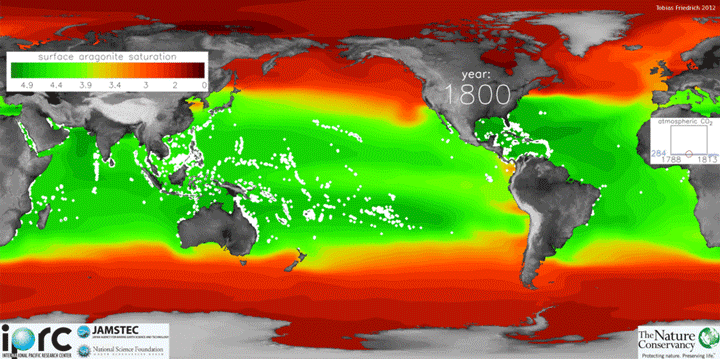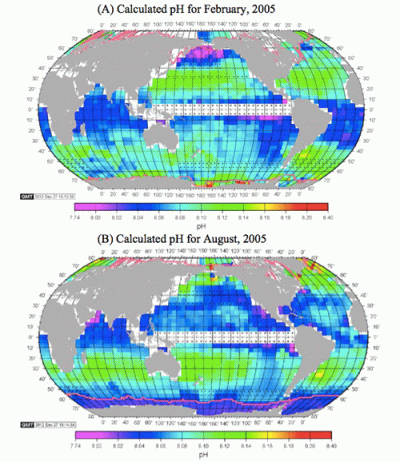News•November 18, 2014
40 Years of Scratching Reveals Ocean Acidification Data

By Brian Kahn
As carbon dioxide levels increase due largely to human emissions, the world’s oceans are becoming highly corrosive to a number of organisms that call it home. But the rate of acidification and related changes are anything but uniform. That’s why a new study aims to set a baseline for nearly every patch of saltwater from sea to acidifying sea so that future acidification and its impacts can be better monitored.
Rates of ocean acidification ever 10 years since 1800 and projected through 2100.
Credit: Tobias Friedrich/University of Hawaii

Taro Takahashi, a geochemist at Lamont-Doherty Earth Observatory who authored the new study in Marine Chemistry, said it has been a decades-long process to compile enough data about ocean acidification to effectively set a benchmark.
Think of the ocean as a giant scratch ticket and the ships and research stations in Bermuda, Hawaii, Iceland and elsewhere as a coin used to slowly scratch away at the surface, revealing just how much the ticket is worth. It took 40 years of scratching but now there’s finally enough data in Takahashi’s eyes to set an accurate baseline.RELATEDWhat Will Survive in Hot, Acidic Oceans?
Another Year, Another Record High for Greenhouse Gases
Ocean Acidification Threatens Food Security, Report
“Without the foundation measurements, we can’t talk about changes,” Takahashi said. He likened it to the Keeling Curve, which has charted the rise of atmospheric carbon dioxide since 1957.
But while the baseline might be a jackpot for scientific research, it also shows that the changes taking place in the high seas could exact a heavy toll. Human emissions of carbon dioxide are far and away the biggest driver of ocean acidification. Oceans take up roughly a quarter of the carbon dioxide produced by human activities. That might reduce the amount of heat building in the atmosphere, but it’s hardly good news as a series of chemistry processes turns it into acid that can destroy corals, dissolve shells and disrupt marine food webs. Those impacts can, in turn, find their way on shore from lost revenue and jobs to decreased coastal protection from storm surges and high tides.
A recent United Nations’ estimate says that unchecked, ocean acidification could cost the globe $1 trillion annually by 2100. In places such as the coastal waters off Washington state, ocean acidification is already eating away at the region’s oyster industry.
Takahashi’s study provides key information that could help improve the accuracy of future loss estimates as well as help plan for how to adapt to changes and reduce the economic toll.
Ocean acidification baseline rates in summer and winter of 2005.
Credit: Takahashi et al., 2014

The current rate of acidification for the ocean is one unseen in the past 300 million years, but the data reveal important regional and seasonal differences between ocean basins. Ocean acidification hot spots dot the globe at different times of year, particularly the northwest Indian Ocean and areas around the tip of South America in the summer, and the Bering Sea in the winter.
Having an accurate look at current seasonality and future expected rates of change provides a stark warning about what the future could look like. According to the study, areas around Bermuda will likely see oceans acidify to levels currently beyond the current seasonal swings in the next 40-50 years, meaning plants and animals will have to adapt to an entirely new environment.
Around Hawaii and the eastern Atlantic, that transition will happen even sooner, likely in the next 20-30 years. What that means for the species that inhabit those regions is of utmost important to scientists and natural resource managers.
While some of these regional differences in acidity and its impacts are fairly well known, others, such as the Indian Ocean hot spot, are still mysteries waiting to be unraveled.
“Anytime you pull on one thing, two other things are moving at the same time so you get this complex set of relationships,” Dwight Gledhill, the deputy director of the National Oceanic and Atmospheric Administration’s Ocean Acidification Program, said.
Gledhill, who wasn’t involved with the study, said the research provides a good foundation to understanding differences in ocean chemistry in different parts of the world, and helps in monitoring reef health. But he was wary of calling it a baseline.
“I tend to steer clear of baseline terms. We missed the baseline about 200 years ago. We’re very much on a moving target here. But that said, you need some reference point to use. It’s an amazing synthesis of data.”
You May Also Like:
Here's How the U.S. Can Adapt to Climate Change
These Photos of Lake Effect Snow Are Crazy
Calif. Plans Nation’s Most Detailed Sea Level Database